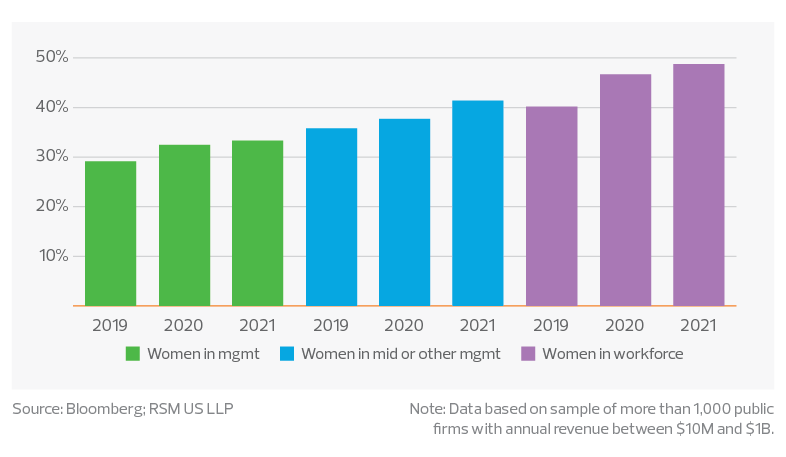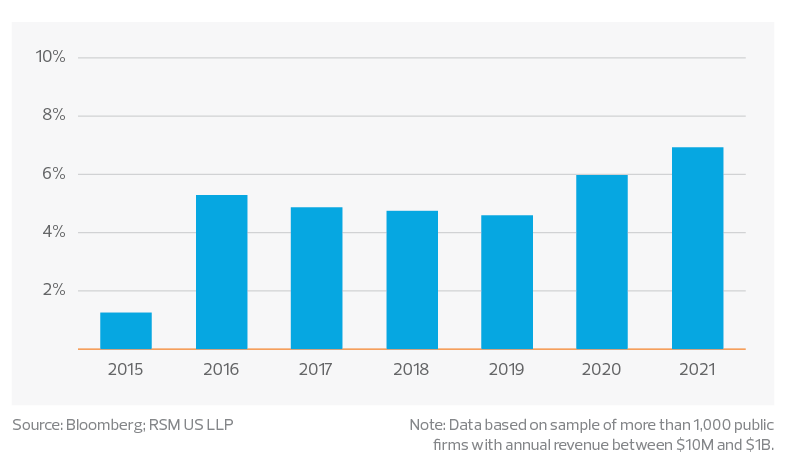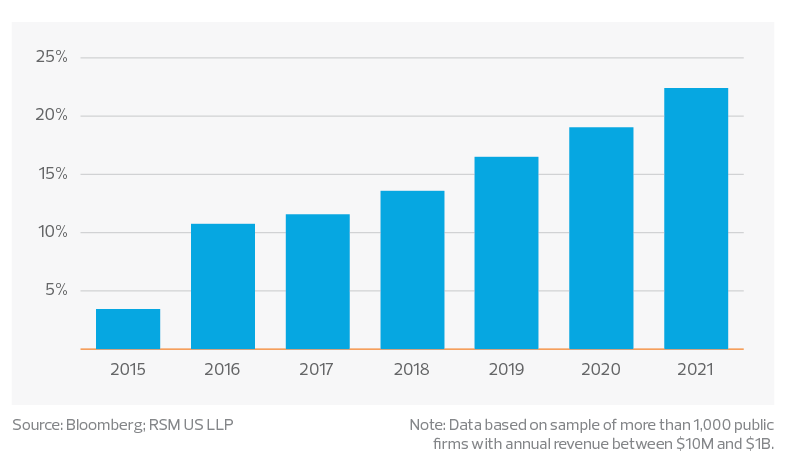Women now make up half the workforce in the United States.
Key takeaways
But representation of women in senior roles in businesses remains low.
If middle market businesses are to thrive, they must attract and retain women in senior management and leadership positions.
One of the fundamental changes in the workplace over the next decade will be the increasing role of women.
Women not only make up half the workforce in the United States but also are the more educated half. College-educated women outnumber men with similar education in the United States, and the gap is growing, especially among younger adults.
Still, representation of women in senior leadership roles in American businesses remains low.
If businesses are to thrive in an era of chronic labor shortages, they must attract, retain, recognize and reward women.
Percentage of women in management in middle market firms

The data
Middle market firms are no exception, and they have been making strides. Between 2019 and 2021, the percentage of female workers in middle market businesses increased from 40.1% to 48.8%, according to a sample survey conducted by Bloomberg. This increase came even as the pandemic placed added burdens on women.
The proportion of women in management has also been on the rise, going from 29.2% in 2019 to 33.2% in 2021, according to the Bloomberg sample survey.
Percentage of middle market firms that have a chairwoman

But the number of women in senior leadership and top management positions has not kept pace with their overall participation in the workforce.
Even as the share of middle market companies that have women leading a board of directors jumped from 1.2% in 2015 to 6.9% in 2021, and as women’s representation on boards overall grew from 3.4% to 22.4%, the disparity remains wide.
Average percentage of board members who are women

ESG performance
With workers still in short supply and gender diversity consistently lagging, it is more critical than ever for organizations to attract and retain talent.
One reason for a company to promote women into leadership roles is that companies are being judged on how well they meet environmental, social and governance criteria.
Our research shows that gender diversity among board members is among the top 10 factors that determine a company’s ESG performance. Increasing the percentage of female board members from 0% to 50% can help improve a company’s ESG performance by 2.7%. In an evaluation process that factors in hundreds of variables, that increase is substantial.
It also affects the bottom line. Research published in the Academy of Management Journal has also shown that firms with more women in leadership positions are more profitable.
Yet in RSM’s latest Middle Market Business Index survey, only 14% of senior executives reported they explicitly include gender equity in their ESG plans, and only 44% include the gender pay gap in their external ESG reporting, a notable decline from last year.
When workers, including women, feel unappreciated at work, they leave, and companies lose out on talent as well as years of experience and relationships that are difficult to replace.
Gender diversity, equity and inclusion offer an alternative: better outcomes for organizations, and for female workers who benefit from a workplace that values them.
The takeaway
Hiring more women in itself is not enough. Conscious efforts must be made to prepare women for and promote them to senior management and leadership positions.
Make no mistake: The economic downturn will not end the talent shortage, a long-term challenge given the aging workforce and slowing immigration. The pandemic only made the shortage more acute as women opted out of the workforce to care for their children, adding to the challenge for employers.
Companies that provide flexibility and family-friendly benefits and culture will continue to attract talent.
As organizations prepare for the future of work, DEI efforts must stay front and center.
Organizations need to create a workplace that values women and enables them to ascend to top leadership positions. This includes providing coaching, mentorship and sponsorship for higher roles. When employees perceive equity in opportunity and the presence of advocates and are put in a position to succeed, the workers, and their businesses, excel.
RSM contributors
More from The Real Economy
The Real Economy
Monthly economic report
A monthly economic report for middle market business leaders.
Industry outlooks
Industry-specific quarterly insights for the middle market.



